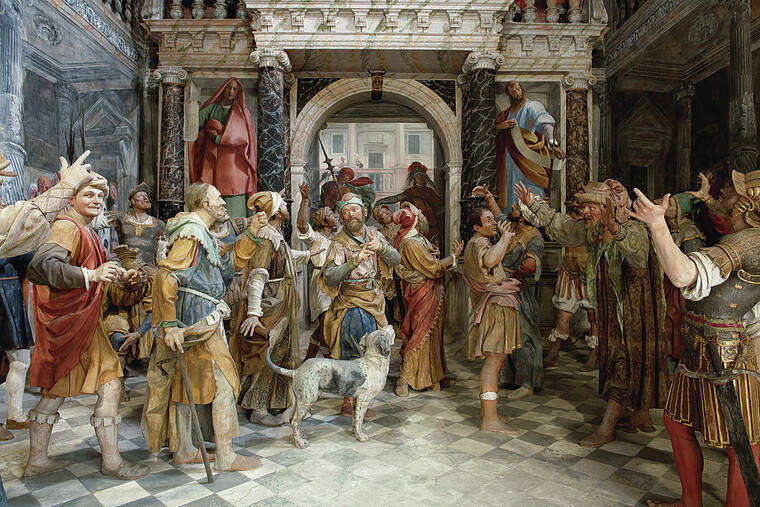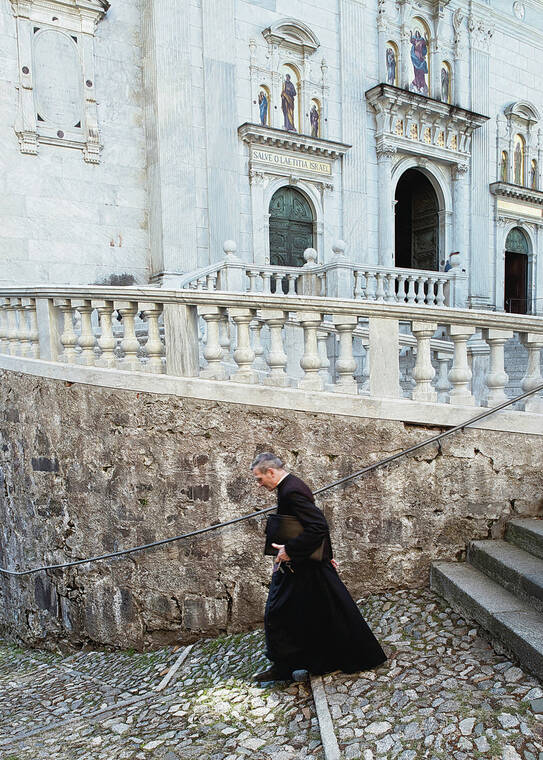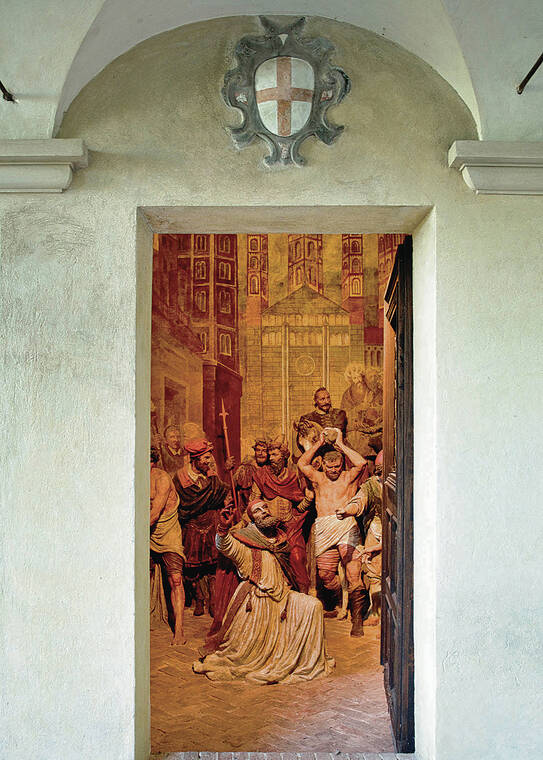A sacred pilgrimage

NEW YORK TIMES
The Ecce Homo chapel at the Sacro Monte of Varallo features the work of the sculptor Giovanni d’Enrico and the painter Pier Francesco Mazzucchelli.

NEW YORK TIMES
The Sacro Monte of Varallo is the oldest of the nine religious complexes in the Italian Alps, in the Piedmont region of Italy.

NEW YORK TIMES
Chapel 1 at the Sacro Monte of Crea features Il Martirio di Sant’Eusebio. At top, the frescoed ceiling of Chapel 5, the Nativity of Mary, at the Sacro Monte of Crea.



The Italian Alps are renowned for their stunning scenery, fine wine and good food. But many travelers are unaware that the region also hosts exquisite Renaissance and Baroque art. Nestled in the mountains and hills of northwestern Italy, just an hour’s drive from Milan, a cluster of Catholic sanctuaries brim with sculptures and frescoes by artists including Gaudenzio Ferrari, Tanzio da Varallo and Pier Francesco Mazzucchelli.
Known as Sacri Monti, or Sacred Mounts, the group of nine pilgrimage stations in the Piedmont and Lombardy regions are recognized by UNESCO as a single World Heritage site. The sanctuaries were built over a period of more than 200 years — from 1486 to 1712. Each has a different story: Five were built by Catholic religious orders, two were commissioned by bishops, and two were built by local communities.
“In Italy, nature, art and religion combine to enrich the humblest lives,” Edith Wharton wrote in her 1905 travel memoir, “Italian Backgrounds,” after visiting three of the sanctuaries. She was utterly captivated by the “sense of harmony and completeness.”
After years of neglect, the Sacri Monti are now experiencing a quiet resurgence, thanks to restoration projects and the popularity of nearby walking trails.
Each of the nine sites — Varallo, Crea, Orta, Varese, Oropa, Ossuccio, Ghiffa, Domodossola and Belmonte — can be easily reached by car or, in the cases of Varallo and Varese, by cable car as well. Many visitors opt for a short trek from the closest town. The sites are so scattered — not to mention that each of them is best appreciated at a slow pace — that it’s advisable to see just one in a single day. Those with time and energy to spare can embark on the Devoto Cammino, a 435-mile hiking trail that links the nine sanctuaries.
In late March, I visited two Sacri Monti, Varallo and Crea, traveling by car from my home in Milan.
Don't miss out on what's happening!
Stay in touch with breaking news, as it happens, conveniently in your email inbox. It's FREE!
Varallo
The Sacro Monte of Varallo, the oldest and perhaps best known of the complexes, was first on my itinerary. It was founded in 1486 by Bernardino Caimi, a Franciscan friar from Milan who dreamed of building a “New Jerusalem” in the Alps. “After the fall of Constantinople, Christian pilgrimages to Jerusalem were becoming too dangerous,” art historian Luca di Palma of the Catholic University of Milan told me. “Thus Caimi, who visited the Holy Land several times, came up with the idea of replicating its major sites in Italy, so that pilgrims could go there instead.”
Varallo’s Sacro Monte, which sits on a hilltop about 2 miles from the town of the same name, has dozens of chapels and some 800 sculptures by Ferrari, Giovanni d’Enrico and da Varallo. Overall, it consists of three groups of chapels that aim at re-creating, on a smaller scale, Nazareth, Bethlehem and Jerusalem. Today, the site, in the midst of a peaceful Alpine forest, is easily accessible by car, cable car and by foot from the town, about an hour’s walk away. There’s even a centuries-old hotel, Vecchio Albergo Sacro Monte, paired with a restaurant specializing in Piedmontese cuisine, right at the gates of the complex.
Among the most impressive of the 45 chapels is the one called Arrivo dei Magi (Arrival of the Magi). Inside, statues by Ferrari, a master of the Northern Italian Renaissance, depict the journey of the three wise men, who, according to the Christian tradition, traveled from the East to pay homage to the newborn Jesus.
Another chapel, Ecce Homo, dating to the early 17th century and featuring the work of d’Enrico, a sculptor, and Mazzucchelli, a painter, depicts Pontius Pilate presenting Jesus, bearing the marks of flagellation and crowned with thorns, to a bitter crowd.
Varallo’s greatest pride — “our Sistine Chapel,” a local ranger told me — is the 38th chapel, known as the Crucifixion, and featuring more than 80 lifelike sculptures by Ferrari and his school. Inside, a sculpture of a dying Jesus is surrounded by a plethora of figures, including a grieving Mary, Roman soldiers playing dice and a dog.
In Ferrari’s day — in the late 1400s and early 1500s — pilgrims could roam among the sculptures, but today Varallo’s chapels are enclosed by wooden and metal grates. “They were added with the Counter-Reformation, in the 16th century,” Di Palma told me. “Pilgrims standing next to Jesus seemed no longer appropriate, so they built grates, so that the viewer had to grasp the representations from the outside, and from a specific angle, their sight guided by the Church.”
Luckily for modern visitors, these grates helped preserve the art throughout the centuries and can be opened, upon request, as they were for me, with guided tours.
Crea
Surrounded by the vineyards of Monferrato and founded in 1589 by Costantino Massino, the prior of a nearby monastery, the Sacro Monte of Crea is perched on a hilltop a few miles from the village of the same name. Unlike other shrines, Crea’s 23 chapels are spaced apart from one another, linked by short trails that total about 1.5 miles.
Visitors are drawn in part by the fact that Crea has a good restaurant, the Ristorante di Crea, in a former inn that once housed pilgrims and serves the best vitello tonnato (a Piedmontese specialty made with veal, tuna and a rich, creamy sauce) I’ve ever had.
On a Saturday in March, the trail inside the sanctuary’s grounds was crowded, but few ventured inside to get a glimpse of its 23 chapels behind the grates. It was a shame because the 23rd chapel, with its depiction of the Coronation of Mary, is breathtaking.
A park guard, Franco Andreone, kindly opened it for me, and I was able to get a close-up view of the early-17th-century chapel’s interior. The art inside is largely the work of Flemish architect and sculptor Jan de Wespin, known as il Tabacchetti. The ceiling is decorated with frescoes and high-reliefs of prophets and saints, while dozens of sculpted angels, secured by a grid of metalwork, drop from the roof, in a triumph of statuary floating above visitors’ heads.
IF YOU GO
Sacri Monti
You can get detailed information about the nine complexes at the official tourist site, Sacrimonti.org. The sanctuaries and their interior installations can also be appreciated with the help of a dedicated app, Sacri Monti, which re-creates the experience of being inside the chapels, as early pilgrims would have been.
Visitors can easily arrange a day trip to the Sacro Monte of Varallo from Milan or Turin, but there is also a hotel (a double starts at 88 euros, or about $93) at the gates of the shrines. A cable car (5 euros) is available, as are guided tours.
Like Varallo, the Sacro Monte of Crea can easily be reached by car from Milan or Turin. Visitors can also stay the night in one of the agriturismi (farm and guesthouses) in the wine region of Monferrato. It also makes an ideal day trip for those visiting the nearby Barolo wine region. For a full appreciation of the complex, sign up via email for a guided tour.
© 2023 The New York Times Company



